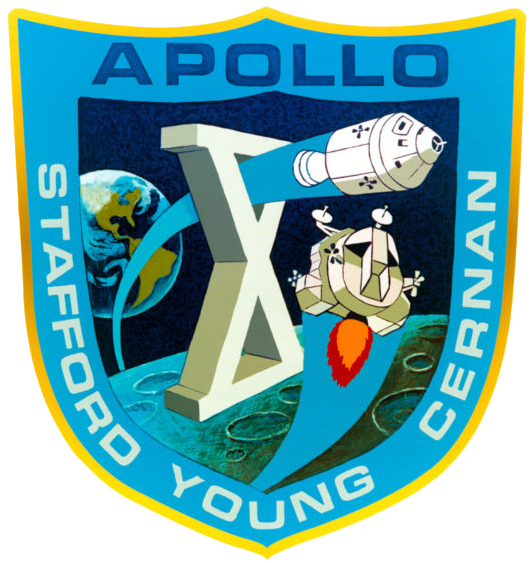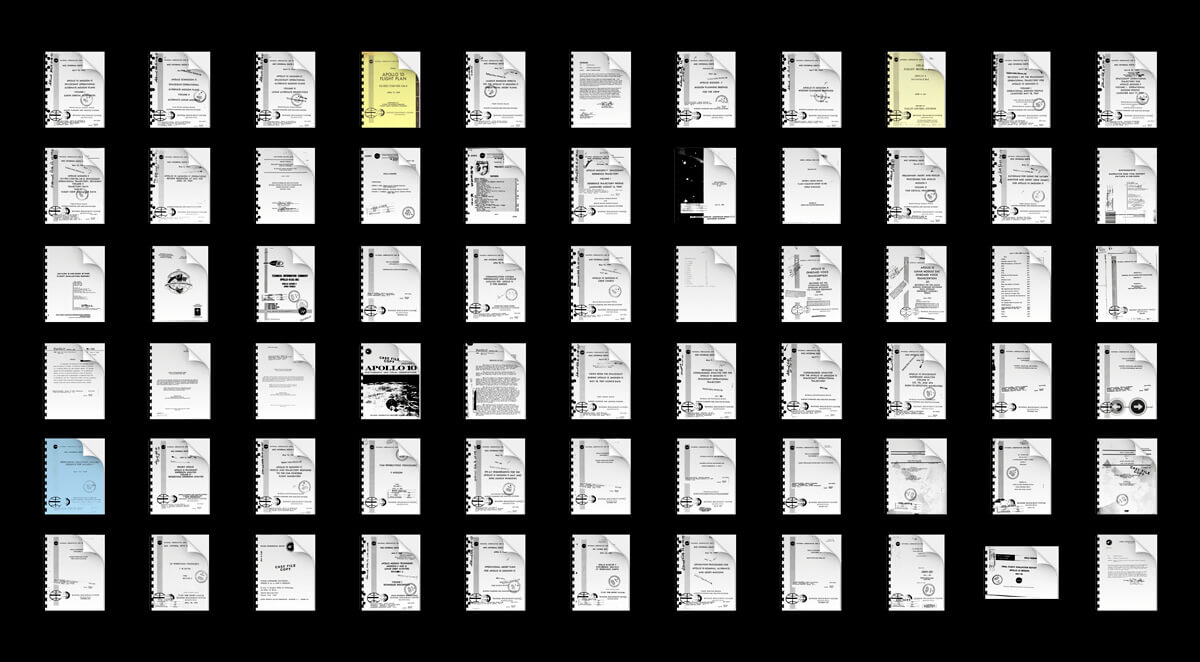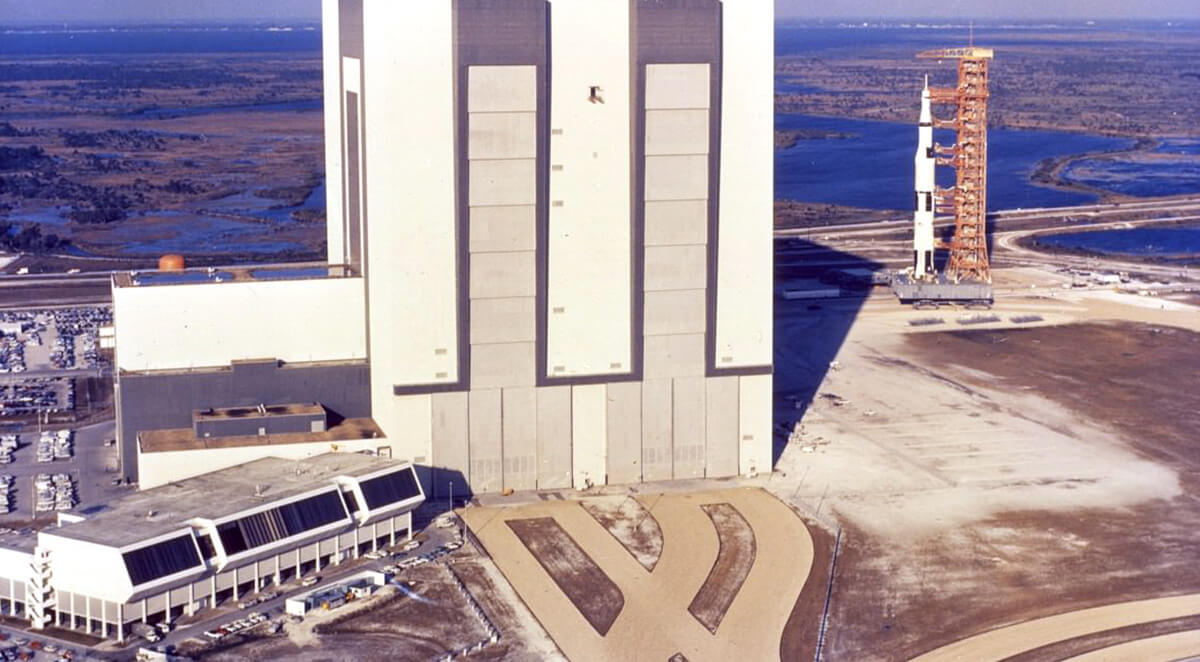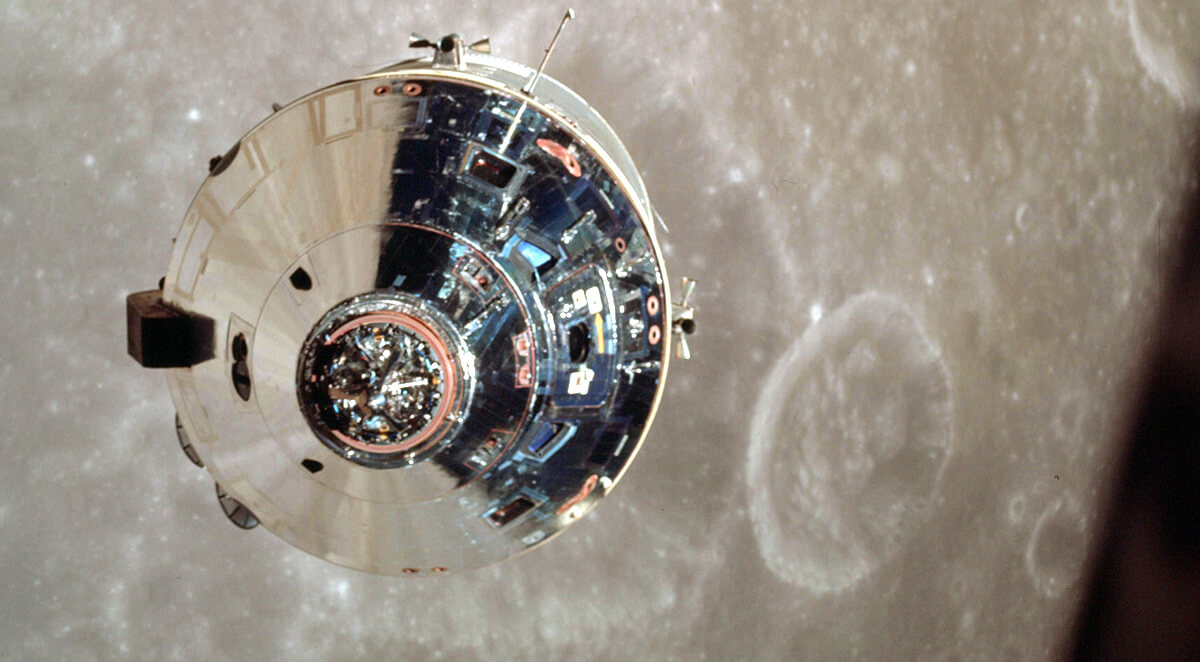Apollo 50th Anniversary Mission PDF eBooks | Apollo 6-17 Complete Set
Apollo 6 | Apollo 7 | Apollo 8 | Apollo 9 | Apollo 10 | Apollo 11 | Apollo 12 | Apollo 13 | Apollo 14 | Apollo 15 | Apollo 16 | Apollo 17
"I believe that this nation should commit itself to achieving the goal, before this decade is out, of landing a man on the Moon and returning him safely to the Earth." - President John F. Kennedy, May 25, 1961
Price: $19.95
- 67 documents & nearly 600 photos
- PDF contains 10,944 pages
- Content is keyword searchable
- Print a personal copy
- Pay via PayPal or Credit Card
- International orders welcome!
- Download files upon payment

The Apollo 10 Command Module is on display at the Science Museum, London, England.
Apollo 10 Mission
Apollo 10 was the fourth crewed mission in the United States Apollo space program, and the second (after Apollo 8) to orbit the Moon.
Launched on May 18, 1969, it was a “dress rehearsal” for the first Moon landing, testing all of the components and procedures, just short of actually landing. The Apollo Lunar Module (LM) was flown to a descent orbit within 8.4 nautical miles (15.6 km) of the lunar surface, at the point where powered descent for landing would normally begin. Its success enabled the first landing to be attempted on the Apollo 11 mission two months later.
Apollo 10 and Apollo 11 were the only Apollo missions whose crew were all veterans of spaceflight. Thomas P. Stafford had flown on Gemini 6 and Gemini 9; John W. Young had flown on Gemini 3 and Gemini 10, and Eugene A. Cernan had flown with Stafford on Gemini 9.
The mission’s call signs were the names of the Peanuts characters Charlie Brown and Snoopy, who became Apollo 10’s semi-official mascots.
This dress rehearsal for a Moon landing brought the Apollo Lunar Module to 8.4 nautical miles (15.6 km) from the lunar surface, at the point where powered descent would begin on the actual landing. Practicing this approach orbit would refine knowledge of the lunar gravitational field needed to calibrate the powered descent guidance system to within 1 nautical mile (1.9 km) needed for a landing.
NASA took special precaution to ensure Stafford and Cernan would not attempt to make the first landing. Gene Cernan was quoted as saying “A lot of people thought about the kind of people we were: ‘Don’t give those guys an opportunity to land, ’cause they might!’ So the ascent module, the part we lifted off the lunar surface with, was short-fueled. The fuel tanks weren’t full. So had we literally tried to land on the Moon, we couldn’t have gotten off.”
Splashdown occurred in the Pacific Ocean on May 26, 1969, at 16:52:23 UTC, about 400 nautical miles (740 km) east of American Samoa and were recovered by the USS Princeton.
According to the 2002 Guinness World Records, Apollo 10 set the record for the highest speed attained by a crewed vehicle: 39,897 km/h (11.08 km/s or 24,791 mph) on May 26, 1969, during the return from the Moon.
PDF Contents
Mission Overview
- Apollo 10 Press Kit
- Apollo 10 Flight Plan
- Reference Trajectory Profile
- Alternate Mission Plans Vol 1 Earth Orbit Alternatives
- Alternate Mission Plans Vol 2 Alternate Lunar Missions
- Alternate Mission Plans Vol 3 Lunar Orbit Rendezvous
- Launch Window Effects
- Mission Operation Report
- Mission Planning Briefing for Crew
- Mission Planning Briefings
- Mission Rules
- Operational Trajectory Vol 1
- Operational Trajectory Vol 1
- Operational Trajectory Vol 2 Part 3
- Operational Review
- Prelaunch GO-NOGO Computations
- Press Briefing
Saturn V Launch & Abort
- AS-505 Postflight Trajectory
- AS-505 Saturn V Flight Evaluation Report
- Preliminary Abort Rescue Vol3 Time Critical Procedures
- Rationale Saturn Monitor Abort Crew Charts
- Saturn IVB Narrative End Item Report
- Saturn SIVB Flight Evaluation Report
- Saturn V Flight Evaluation Report
- Technical Information Summary AS-505 Launch Vehicle
Crew & Communications
- Comm System Performance
- Comms Systems Analysis
- Crew Charts
- Crew Training
- Onboard Voice Transcription CSM
- Onboard Voice Transcription LM
- PAO Air-to-Ground Transcriptions
- Technical Voice Transcription
Photography & Video
- Bellcom Photo Debrief
- Photo Index
- Photography Index
- Photography Visual Observations
- Television
- Views from the Spacecraft
Trans-Lunar
- Consumables Analysis Spacecraft Operational Trajectory Rev1
- Consumables Analysis
- Dispersion Analysis Vol3 LOI, TEI, APS Maneuvers
- GNC Systems Performance Analysis Supplement 2
- GNC Systems Performance Analysis
- Operational Spacecraft Attitude Sequence
- Rendezvous Dispersion Analysis
- Vehicle Trajectory Response CSM Maneuvers
- CSM Rendezvous Procedures
- CSM SPS DeltaV Requirements
Lunar Operations
- Descent Propulsion System Final Flight Evaluation
- Docking Capture Boundaries
- LM APS Final Flight Evaluation
- LM APS Final Flight Evaluation
- LM Descent Phasing
- LM DPS Final Flight Evaluation TRW
- LM DPS Final Flight Evaluation
- LM Rendezvous Procedures
- Lunar Landmark Locations Apollo 8-12
- Lunar Orbit Activities
- Operational Abort Plan
- Performance Analysis Rendezvous Charts
- Separation Procecures Nominal Alternate Abort Missions
Entry
- Entry Postflight Analysis
- Entry Summary
Mission Debrief
- Final Flight Evaluation Report
- Postlaunch Report
- Technical Crew Debriefing
Apollo 10 Videos
Apollo 10 Documentary Videos
Apollo 10 Full Mission Videos from LunarModule5
Complete Apollo 10 mission videos at LunarModule5’s YouTube Channel
Apollo 50th Anniversary Mission PDF eBooks | Apollo 6-17 Complete Set
Apollo 6 | Apollo 7 | Apollo 8 | Apollo 9 | Apollo 10 | Apollo 11 | Apollo 12 | Apollo 13 | Apollo 14 | Apollo 15 | Apollo 16 | Apollo 17








